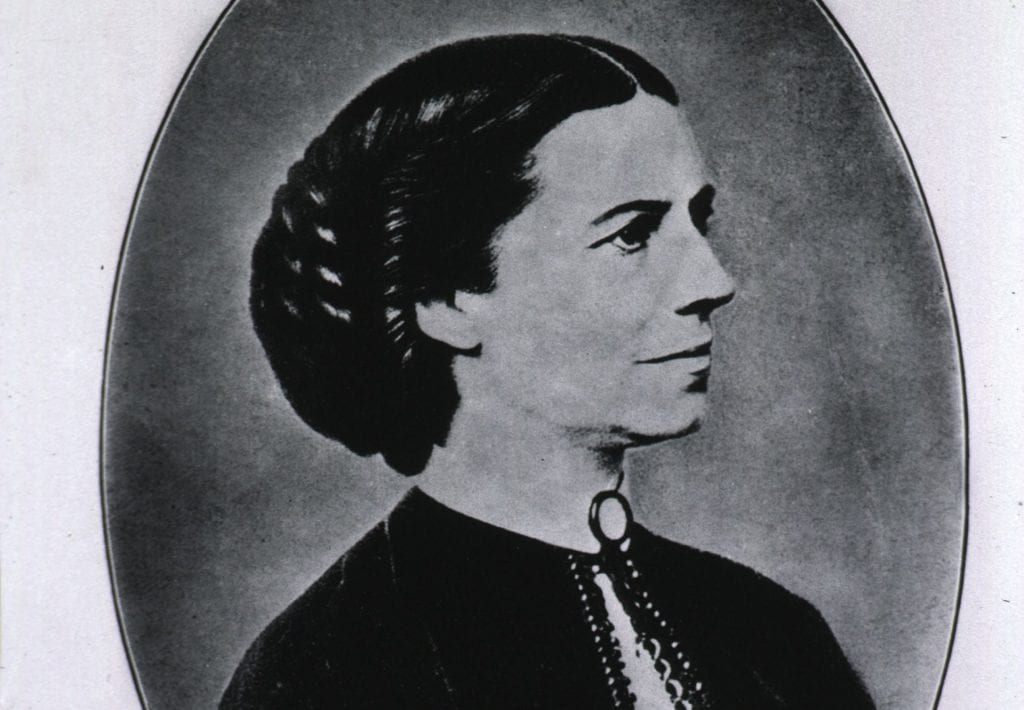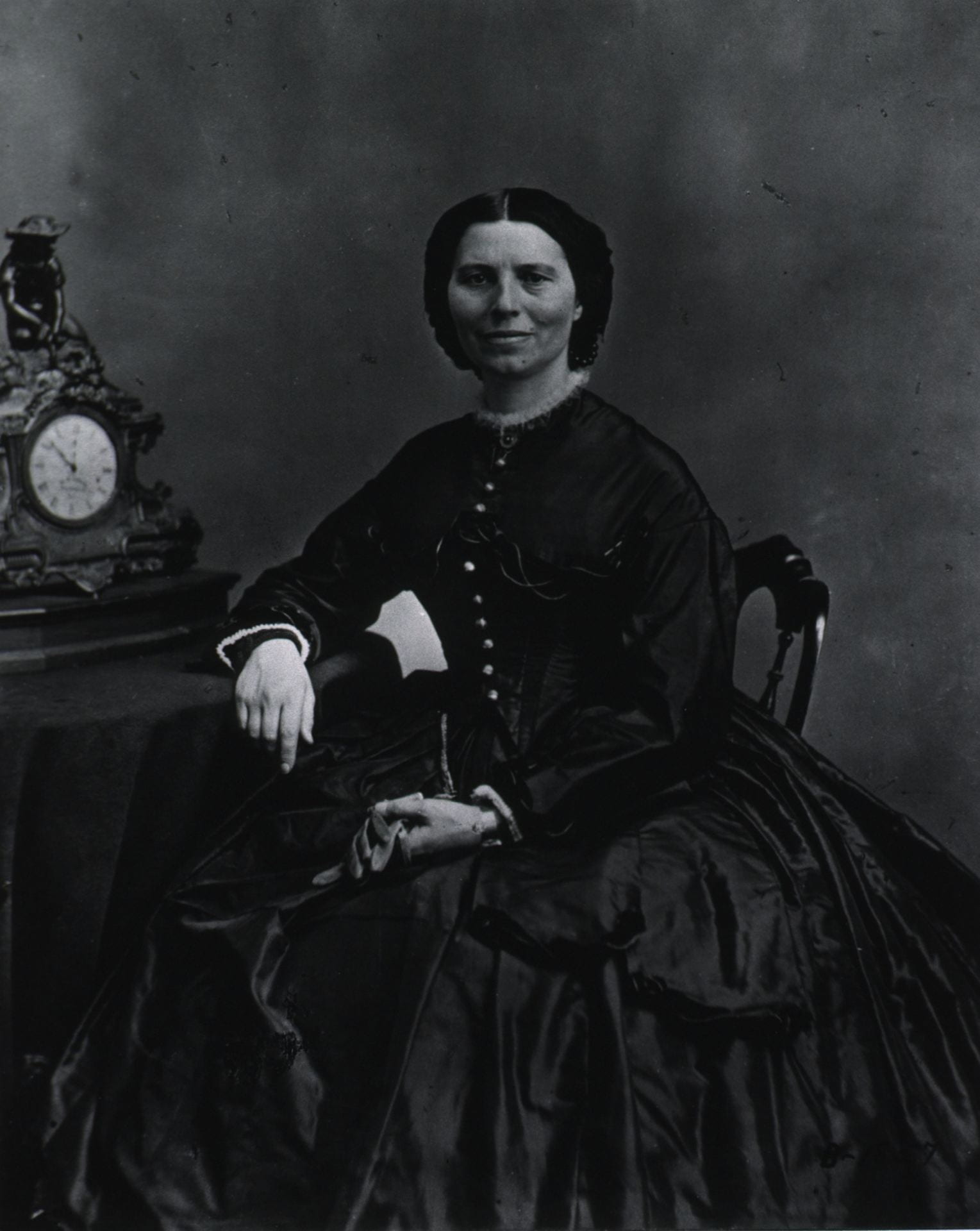
In an effort to remain accountable to communities who have been negatively impacted by past and present medical injustices, the staff at Himmelfarb Library is committed to the work of maintaining an anti-discriminatory practice. We will uplift and highlight diverse stories throughout the year, and not shy away from difficult conversations necessary for health sciences education. To help fulfill this mission, today's blog post will cover Clara Barton.
Clara (Clarissa) Harlowe Barton, is perhaps best known as the founder of the American Red Cross. But Barton’s impact stretches far beyond her work with the Red Cross. “Her intense devotion to serving others resulted in enough achievements to fill several ordinary lifetimes” (American Red Cross, n.d.).
Born in 1821 in North Oxford, Massachusetts, she was the youngest of five children. When she was 11 years old, an older brother was seriously injured in a fall. Barton spent two years nursing him back to health until he was fully recovered. While Barton would never have any formal training as a nurse, this experience proved to be indispensable. She later wrote about the experience stating:
“I learned to take all directions for his medicine from his physician…and to administer them like a genuine nurse. My little hands became schooled to the handling of the great, loathsome, crawling leeches which were at first so many snakes to me, and no fingers could so painlessly dress the angry blisters; and thus it came about, that I was the accepted and acknowledged nurse of a man almost too ill to recover.”
(Clara Barton Missing Soldiers Office Museum, 2021)
Despite this early nursing experience, Barton would not embrace a nursing career until later in life. At the age of seventeen, Barton worked as a teacher in North Oxford, Massachusetts (Clara Barton Birthplace Museum, 2017). Twelve years later, she opened the first free public school in Bordertown, New Jersey (Clara Barton Birthplace Museum, 2017). The school grew from only six students on the first day of classes to more than 200 students by the end of the school year (Clara Barton Birthplace Museum, 2017). When the school opened in the fall of 1853, Barton was shocked to learn that a man had been hired as the school’s principal, earning twice her salary to run the school that she had founded and made successful. Outraged at this news, she resigned her teaching position. “I may sometimes be willing to teach for nothing, but if paid at all, I shall never do a man’s work for less than a man’s pay” she proclaimed.
The following year, Barton moved to Washington, D.C. to be “one of only a few female clerks at the US Patent Office and the only woman in her office receiving a salary equal to the male clerks” (National Park Service, 2020). As one of the first women employees of the federal government, she faced harassment from her male colleagues who “tried to besmirch her good name and get her fired” (National Park Service, 2020).

In 1861, Barton moved into a boarding house on 7th St., now the site of the Clara Barton Missing Soldiers Office Museum. The Civil War had just begun, and Barton saw a need for providing supplies and personal assistance to men in uniform. She began collecting supplies and obtained passes from the government to deliver her supplies and services to the front lines and field hospitals. After appearing “at a field hospital at midnight with a wagon-load of supplies,” she became known as the “Angel of the Battlefield” (American Red Cross, n.d.). She nursed, comforted, and cooked for the wounded often at great personal risk to her own safety. On one account, “as she knelt down to give one man a drink, she felt her sleeve quiver. She looked down, noticed a bullet hole in her sleeve, and then discovered that the bullet had killed the man she had been helping” (National Park Service, 2020).
As the war drew to a close, Barton often found herself responding to letters from family members looking for missing soldiers. Again seeing a need, Barton established the Office of Correspondence with Friends of the Missing Men of the United States Army. Barton and her assistants received and answered more than 63,000 letters and identified more than 22,000 missing men. Some of these men were still alive. Years later, the “Red Cross established a tracing service, one of the organization’s most valued activities today” (American Red Cross, n.d.).
In 1869, Barton took a trip to Switzerland where she learned about the International Red Cross. Barton appealed to three sitting US Presidents to sign the Geneva Treaty (American Red Cross, n.d.). In 1882, President Chester Authur signed the treaty, and it was ratified by the Senate (American Red Cross, n.d.). Under Barton’s leadership, the American Red Cross helped victims of forest fires in Michigan, survivors of the Johnstown flood, famine in Russia, hurricane and tidal wave relief in a predominantly African-American community in the Sea Islands of South Carolina just to name a few (American Red Cross, n.d.). “The American Red Cross, with Barton at its head, was largely devoted to disaster relief for the first 20 years of its existence” (American Red Cross, n.d.).

A Red Cross supply warehouse in Glen Echo, Maryland served as the first permanent headquarters of the Red Cross, as well as Barton’s home. She lived here for the last 15 years of her life until her death on April 12, 1912. This site is now the Clara Barton National Historic Site. While this site is currently closed due to the pandemic, it is well worth touring if you have the opportunity in the future.
In 1904, at the age of 82, Barton stepped down from the Red Cross. Today’s American Red Cross still focuses on providing disaster relief, and the mission has been expanded to include: providing lifesaving blood through their blood donation program; providing training and certification courses in lifesaving skills such as first aid, CPR, and AED use; providing international disaster relief services; and helping military families prepare for and cope with the challenges of military service.
During her lifetime, Barton was also a strong supporter of women’s rights. She supported suffragists such as Susan B. Anthony, Elizabeth Cady Stanton, and Frances D. Gage, and often spoke publicly in favor of equal rights for women (Clara Barton Missing Soldiers Office Museum, 2021). Barton dedicated her life to the service of others as a teacher, a Civil War nurse, and founder of the American Red Cross. By dedicating her life to the care of others, she left a legacy of caregiving and disaster relief in America and abroad.
References:
American Red Cross. (n.d.) Founder Clara Barton. Red Cross. https://www.redcross.org/content/dam/redcross/enterprise-assets/about-us/history/history-clara-barton-v5.pdf
Clara Barton Missing Soldiers Office Museum. (2021). Biography. https://www.clarabartonmuseum.org/bio/
[Clara Barton portrait 1]. U.S. National Library of Medicine Digital Collections. http://resource.nlm.nih.gov/101409980
[Clara Barton portrait 2]. U.S. National Library of Medicine Digital Collections. http://resource.nlm.nih.gov/101409986
Highsmith, C.M., photographer. Clara Barton’s Home, Glen Echo, Maryland. United States Maryland Glen Echo, None. [Between 1980 and 2006] [Photograph] Retrieved from the Library of Congress, https://www.loc.gov/item/2011631520/
National Park Service. (June 15, 2020). Clara Barton. https://www.nps.gov/people/clara-barton.htm



Educator and humanitarian Clara Barton helped distribute needed supplies to helping the homeless and poor, and writing about her life. Learn about Clara Barton, the founder of the American Red Cross who led the Barton risked her life to bring supplies and support to soldiers in the field. https://www.faimission.org/